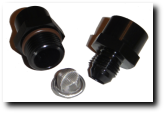WHY INSTALL AN IN-LINE
TURBO OIL SUPPLY FILTER?
|
The Myth...
As long as your oil filter is clean and working there is no need to install an in-line oil filter on your turbocharger oil supply line and that doing so really adds no benefits or protection from premature failure caused by oil debris contamination.
! WRONG !
|
|
MYTH BUSTER FACTS
Under ideal conditions, the bypass valve will never open. When it opens, the oil by passes the filter and goes on through to the motor, obviously unfiltered. It is a safety valve.
However, in real world operation, it opens often.
figure 1
Oil Filter Safety Valve Illustration
When Does the Oil Filter Safety Valve Open?
EXAMPLE 1
One example is when you start the motor when cold. The oil is thick and does not pass easily through the filtration medium, thus building up to a high pressure drop. So, the bypass valve opens to prevent oil-starvation of the motor. How long it stays open is dependent on how cold the oil is and how long it takes to get near operating temperature. When the pressure drop across the filtration medium drops below the bypass valve setting the valve then closes.
EXAMPLE 2
Another example is when you are racing and can occur when the motor is fully warmed. At idle, the oil pressure is about 10 to 15 psi, and the pressure drop across the filter is about 1 or 2 psi. You take off towards the redline, and quickly build oil pressure. During that full-throttle acceleration the pressure drop across the filter will exceed the bypass setting, and send unfiltered oil to the motor, until the pressure across the filter has time to equalize. During a drag race, shifting through the gears, the bypass will open several times.
EXAMPLE 3
A third example, which you should never experience with frequent oil and filter changes, is when a filter becomes clogged. A spin-on filter can commonly hold 10 to 20 grams of trash before it becomes fully clogged. The bypass valve opening is the only way to keep the motor from becoming oil-starved if the filter becomes clogged.
Video - How the Typical Engine Oil Filter By-pass Valve Operaes
... MYTH BUSTED ...
According to Purolator, the Honda OEM filter bypass setting is 12 to 14 psi. WIX (NAPA Gold) builds their oil filters with a bypass setting of 8 to 11 psi, while AC Delco builds theirs to a setting of 11 to 17 psi. How much do these differences matter? I don't think anyone knows, even the engineers, and each has its own set of advantages and disadvantages.
- If you do lots of racing, you're probably better off with a higher bypass setting.
- If you do lots of *cold* starting, especially in the winter, or seldom change your filter, I think you're better off with a lower bypass setting.
However, with few exceptions, bypass pressures for spin-on filters run in the 8 to 17 psi range, and any of them should work acceptably.
A Simple Bolt On Factory Fit Solution
 In your turbocharged car, when the bypass valve is open, your turbocharger’s hardy but delicate bearings are possibly being exposed to debris and abrasive contaminants that can very quickly or over time, wear the bearings and turbine shaft and cause the turbo to prematurely fail. So making an investment in an in-line turbo oil supply line filter (and keeping it clean) is actually a very good, very wise investment and is a preventative step to help preserve and prolong the normal operation of your expensive turbocharger. The in-line turbo oil supply line filter serves as extra insurance, a device to greatly reduce the amount of abrasive debris that might reach the bearings and be the source for a debris related bearing failure. In your turbocharged car, when the bypass valve is open, your turbocharger’s hardy but delicate bearings are possibly being exposed to debris and abrasive contaminants that can very quickly or over time, wear the bearings and turbine shaft and cause the turbo to prematurely fail. So making an investment in an in-line turbo oil supply line filter (and keeping it clean) is actually a very good, very wise investment and is a preventative step to help preserve and prolong the normal operation of your expensive turbocharger. The in-line turbo oil supply line filter serves as extra insurance, a device to greatly reduce the amount of abrasive debris that might reach the bearings and be the source for a debris related bearing failure.
Protect your turbo Dodge Garrett TI and TII style turbocharger from foreign particles that can harm the internal precision bearings, critical thrust surfaces and turbine shaft with our exclusive oil supply line with the integrated and reusable 80 micron oil filtration system.
|